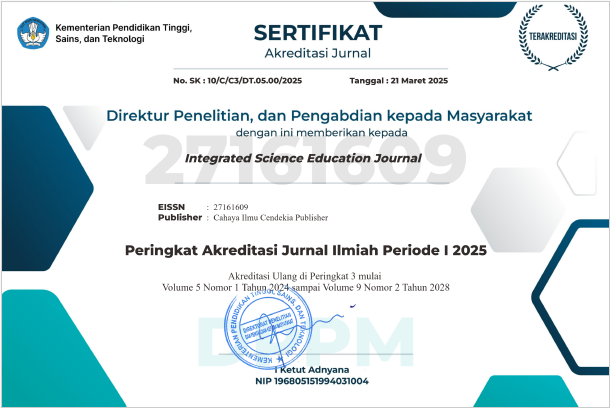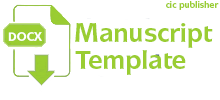Evaluating Science Readiness of Pre-Service Elementary Teachers Through Diagnostic Assessment and Parental Feedback: Implications for Teacher Education
Abstract
Purpose of the study: This study aimed to measure the science education readiness of BEEd pre-service teachers through diagnostic assessments, gather parental feedback on curriculum implementation and available resources, and identify priority areas for improvement that will enhance licensure preparation, instructional quality, and stakeholder engagement in teacher education.
Methodology: The study employed a census of BEEd pre-service teachers and their parents from Bataan Peninsula State University-Bagac Campus during Academic Year 2024–2025. Data were collected through a diagnostic test aligned with the Licensure Examination for Teachers (LET) science component, structured parental questionnaires, and a 4-point Likert-scale survey. Descriptive statistics were used to analyze the diagnostic test and survey responses, while thematic analysis was applied to the qualitative parental feedback.
Main Findings: The diagnostic test results showed a low mean science score of 2.68 out of 10 among BEEd pre-service teachers. Parents reported satisfaction with curriculum relevance and teaching quality but expressed concerns about the adequacy of science resources, the consistency of academic updates, and the level of school–parent communication. Thematic analysis confirmed the need for improved instructional materials, strengthened stakeholder engagement, enhanced academic support systems, and the integration of culturally responsive and technology-based approaches in science education.
Novelty/Originality of this Study: This study is distinct in combining diagnostic test results with parental feedback to evaluate the readiness of BEEd pre-service teachers in science education. While earlier works have mainly focused on student performance, this research highlights the importance of parental perspectives, curriculum evaluation, and innovative approaches.
References
R. Peng, R. A. Razak, and S. H. Halili, “Investigating the factors affecting ICT integration of in-service teachers in Henan Province, China: Structural equation modeling,” Humanit. Soc. Sci. Commun., vol. 10, p. 1, 2023, doi: 10.1057/s41599-023-01871-z.
Z. L. Avelino, “Learning the concept of genes, DNA, and chromosome through developed virtual laboratory website,” JPBI (J. Pendidik. Biol. Indones.), vol. 11, no. 1, pp. 399–405, 2025, doi: 10.22219/jpbi.v11i1.39774.
R. R. Fiscal and A. G. Roman, “Pre-licensure examination as predictor of licensure examination for teachers result,” Int. J. Eval. Res. Educ., vol. 11, no. 1, pp. 136–142, 2022, doi: 10.11591/ijere.v11i1.22133.
M. Solis-Foronda, “Predictors of Licensure Examination for Teachers (LET) Performance: A mediation analysis,” in ICDTE '17: Proceedings of the 1st International Conference on Digital Technology in Education, 2017, pp. 74–78, doi: 10.1145/3134847.3134863.
M. B. Cahapay, “System admission test and licensure examination for teachers: The case of passed and conditional groups,” Asian J. Univ. Educ., vol. 17, no. 4, pp. 251–258, 2021, doi: 10.24191/ajue.v17i4.9809.
L. C. Cabanela, “Data-Driven Career Placement Examination System with Prediction Model in Forecasting Licensure Performance Using Regression Techniques,” Int. J. Manage. Thinking, vol. 1, no. 2, 2023, doi: 10.56868/ijmt.v1i2.37.
L. Nathans, A. Brown, M. Harris, and A. Jacobson, “Preservice teacher learning about parent involvement at four universities,” Educ. Stud., vol. 48, no. 4, pp. 529–548, 2022, doi: 10.1080/03055698.2020.1793297.
A. S. Abana, A. B. Ramos, B. K. Gumarang Jr., and J. Z. Tarun, “The graduates tracer study: Bachelor of elementary education program,” Int. J. Multidiscip. Appl. Bus. Educ. Res.., vol. 2, no. 10, pp. 918–927, 2021, doi: 10.11594/ijmaber.02.10.09.
J. Pentang, D. R. Perez, K. H. Cuanan, M. B. Recla, R. T. Dacanay, R. M. Bober, C. E. Dela Cruz, S. P. Egger, R. L. Herrera, C. M. Illescas, J. M. Salmo, M. L. Bucad Jr., J. V. Agasa, and N. A. A. Abaca, “Tracer study of teacher education graduates of Western Philippines University-Puerto Princesa Campus: Basis for curriculum review and revision,” Int. J. Multidiscip. Appl. Bus. Educ. Res., vol. 3, no. 3, pp. 419–432, 2022, 10.11594/ijmaber.03.03.12.
A. H. Al-Kassem, “Accreditation of academic programs: Implications on quality governance and administration of Taguig City University,” J. Posit. Sch. Psychol., vol. 6, no. 4, pp. 3908–3923, 2022.
M. Andrée and L. Hansson, “Industry, science education, and teacher agency: A discourse analysis of teachers’ evaluations of industry-produced teaching resources,” Sci. Educ., vol. 105, no. 2, pp. 353–383, 2021, doi: 10.1002/sce.21607.
M. E. Culp and K. Salvador, “Music teacher education program practices: Preparing teachers to work with diverse learners,” J. Music Teach. Educ., vol. 30, no. 2, pp. 51–64, 2021, doi: 10.1177/105708372098.
R. Karchmer-Klein and H. Konishi, “A mixed-methods study of novice teachers’ technology integration: Do they leverage their TPACK knowledge once entering the profession?,” J. Res. Technol. Educ., vol. 55, no. 3, pp. 490–506, 2023, doi: 10.1080/15391523.2021.1976328.
A. D. Endeshaw, “Examining EFL teachers' knowledge, attitudes and perceived practices of differentiated instruction in English classrooms,” J. Cakrawala Pendidik., vol. 42, no. 3, pp. 760–770, 2023, doi: 10.21831/cp.v42i3.49953.
J. Colwell, K. Gregory, and V. Taylor, “Examining preservice teachers’ perceptions of planning for culturally relevant disciplinary literacy,” J. Teach. Educ., vol. 72, no. 2, pp. 195–208, 2021, doi: 10.1177/00224871209138
A. J. Kola and A. A. Abdulwasiu, “Teachers’ effective use of educational resources and their effect on students’ learning,” Univ. Park Bulten, vol. 12, no. 2, pp. 83–98, 2023, doi: 10.22521/unibulletin.2023.122.4.
R. S. Malahay, “Area of specialization and teaching performance of the secondary science teachers in Negros Oriental, Philippines,” J. Sci. Res. Rep., vol. 27, no. 11, pp. 97–103, 2021, doi: 10.9734/jsrr/2021/v27i1130461.
U. H. Lai, K. S. Wu, T. Y. Hsu, and J. K. C. Kan, “Evaluating the performance of ChatGPT-4 on the United Kingdom medical licensing assessment,” Front. Med., vol. 10, p. 1240915, 2023, doi: 10.3389/fmed.2023.1240915.
H. Zong, J. Li, E. Wu, R. Wu, J. Lu, and B. Shen, “Performance of ChatGPT on Chinese national medical licensing examinations: A five-year examination evaluation study for physicians, pharmacists and nurses,” BMC Med. Educ., vol. 24, no. 1, p. 143, 2024, doi: 10.1186/s12909-024-05125-7.
A. Farazouli, T. Cerratto-Pargman, K. Bolander-Laksov, and C. McGrath, “Hello GPT! Goodbye home examination? An exploratory study of AI chatbots impact on university teachers’ assessment practices,” Assess. Eval. High. Educ., vol. 49, no. 3, pp. 363–375, 2024, doi: 10.1080/02602938.2023.2241676.
A. Farazouli, T. Cerratto-Pargman, K. Bolander-Laksov, and C. McGrath, “Hello GPT! Goodbye home examination? An exploratory study of AI chatbots impact on university teachers’ assessment practices,” Assess. Eval. High. Educ., vol. 49, no. 3, pp. 363–375, 2024, doi: 10.1080/02602938.2023.2241676.
J. A. Flores-Cohaila, A. García-Vicente, S. F. Vizcarra-Jiménez, J. P. De la Cruz-Galán, J. D. Gutiérrez-Arratia, B. G. Q. Torres, and A. Taype-Rondan, “Performance of ChatGPT on the Peruvian national licensing medical examination: Cross-sectional study,” JMIR Med. Educ., vol. 9, no. 1, p. e48039, 2023, doi: 10.2196/48039.
K. Guo and D. Wang, “To resist it or to embrace it? Examining ChatGPT’s potential to support teacher feedback in EFL writing,” Educ. Inf. Technol., vol. 29, no. 7, pp. 8435–8463, 2024, doi: 10.1007/s10639-023-12146-0.
F. Jia, D. Sun, and C. K. Looi, “Artificial intelligence in science education (2013–2023): Research trends in ten years,” J. Sci. Educ. Technol., vol. 33, pp. 94–117, 2024, doi: 10.1007/s10956-023-10077-6.
E. Klang, S. Portugez, R. Gross, R. Kassif Lerner, A. Brenner, M. Gilboa, et al., “Advantages and pitfalls in utilizing artificial intelligence for crafting medical examinations: A medical education pilot study with GPT-4,” BMC Med. Educ., vol. 23, p. 772, 2023, doi: 10.1186/s12909-023-04752-w.
J. R. Kogan, K. E. Hauer, and E. S. Holmboe, “The dissolution of the Step 2 Clinical Skills Examination and the duty of medical educators to step up the effectiveness of clinical skills assessment,” Acad. Med., vol. 96, no. 9, pp. 1242–1246, 2021, doi: 10.1097/ACM.0000000000004216.
A. B. Mbakwe, I. Lourentzou, L. A. Celi, O. J. Mechanic, and A. Dagan, “ChatGPT passing USMLE shines a spotlight on the flaws of medical education,” PLoS Digit. Health, vol. 2, no. 2, p. e0000205, 2023, doi: 10.1371/journal.pdig.0000205
D. Seco, S. Grösser, and A. M. Pedrosa, “Use of generative artificial intelligence tools in higher education environments,” Multidiscip. J. Educ. Soc. Technol. Sci., vol. 12, no. 1, pp. 156–175, 2025, doi: 10.4995/muse.2025.23623.
S. Wójcik, A. Rulkiewicz, P. Pruszczyk, W. Lisik, M. Poboży, and J. Domienik-Karłowicz, “Reshaping medical education: Performance of ChatGPT on a PES medical examination,” Cardiol. J., vol. 31, no. 3, pp. 442–450, 2024, doi: 10.5603/cj.97517.
X. Xu, Y. Chen, and J. Miao, “Opportunities, challenges, and future directions of large language models, including ChatGPT in medical education: A systematic scoping review,” J. Educ. Eval. Health Prof., vol. 21, no. 6, 2024, doi: 10.3352/jeehp.2024.21.6.
A. K. Abdallah and M. B. Musah, “Effects of teacher licensing on educators’ professionalism: UAE case in local perception,” Heliyon, vol. 7, no. 11, 2021, doi: 10.1016/j.heliyon.2021.e08348.
A. M. Abu-Tineh, M. H. Romanowski, Y. Chaaban, H. Alkhatib, N. Ghamrawi, and Y. M. Alshaboul, “Career advancement, job satisfaction, career retention, and other related dimensions for sustainability: A perception study of Qatari public school teachers,” Sustainability, vol. 15, no. 5, p. 4370, 2023, doi: 10.3390/su15054370.
R. J. Collie, “Teachers’ work motivation: Examining perceived leadership practices and salient outcomes,” Teach. Teach. Educ., vol. 135, p. 104348, 2023, doi: 10.1016/j.tate.2023.104348.
G. Heilporn, S. Lakhal, and M. Bélisle, “An examination of teachers’ strategies to foster student engagement in blended learning in higher education,” Int. J. Educ. Technol. High. Educ., vol. 18, no. 1, p. 25, 2021, doi: 10.1186/s41239-021-00260-3.
B. Kye, N. Han, E. Kim, Y. Park, and S. Jo, “Educational applications of metaverse: Possibilities and limitations,” J. Educ. Eval. Health Prof., vol. 18, 2021, doi: 10.3352/jeehp.2021.18.32.
C. M. Leider, M. Colombo, and E. Nerlino, “Decentralization, teacher quality, and the education of English learners: Do state education agencies effectively prepare teachers of ELs?,” Educ. Policy Anal. Arch., vol. 29, p. 100, 2021, doi: 10.14507/epaa.29.5279.
R. S. Malahay, “Area of specialization and teaching performance of the secondary science teachers in Negros Oriental, Philippines,” J. Sci. Res. Rep., vol. 27, no. 11, pp. 97–103, 2021, doi: 10.9734/jsrr/2021/v27i1130461.
E. J. Mantilla, M. Hungo, and L. Casinillo, “School-based in-service training (INSET) management for personal and professional development of public school principals and teachers,” St. Theresa J. Humanit. Soc. Sci., vol. 10, no. 1, pp. 155–173, 2024.
A. Naciri, M. Radid, A. Kharbach, and G. Chemsi, “E-learning in health professions education during the COVID-19 pandemic: A systematic review,” J. Educ. Eval. Health Prof., vol. 18, 2021, doi: 10.3352/jeehp.2021.18.27.
P. Newton and M. Xiromeriti, “ChatGPT performance on multiple choice question examinations in higher education: A pragmatic scoping review,” Assess. Eval. High. Educ., vol. 49, no. 6, pp. 781–798, 2024, doi: 10.1080/02602938.2023.2299059.
J. C. Park, H. J. E. Kwon, and C. W. Chung, “Innovative digital tools for new trends in teaching and assessment methods in medical and dental education,” J. Educ. Eval. Health Prof., vol. 18, 2021, doi: 10.3352/jeehp.2021.18.13.
H. Putman and K. Walsh, State of the States 2021: Teacher Preparation Policy. Washington, DC, USA: Natl. Council Teach. Qual., 2021.
D. B. Bihasa, H. B. Madrigal, and E. M. Ladia, “A journey of a Filipino pre-service teacher before entering the Department of Education,” Eur. J. Educ. Res., vol. 3, no. 1, Aug. 2024, doi: 10.56773/ejer.v3i1.41.
R. A. A. Recede, R. A. Asignado, and M. A. Castro, “Out-of-field teaching: Impact on teachers’ self-efficacy and motivation,” Int. J. Multidiscip. Appl. Bus. Educ. Res., vol. 4, no. 2, pp. 519–533, 2023, doi: 10.11594/ijmaber..04.02.19.
S. M. Saha, S. A. Pranty, M. J. Rana, M. J. Islam, and M. E. Hossain, “Teaching during a pandemic: Do university teachers prefer online teaching?,” Heliyon, vol. 8, no. 1, 2022, doi: 10.1016/j.heliyon.2021.e08663.
F. A. Salendab and Y. C. Dapitan, “Performance of private higher education institutions and the school heads’ supervision in South Central Mindanao,” Psychol. Educ., vol. 58, no. 3, pp. 3980–3997, 2021.
N. Suprapto, B. K. Prahani, and T. H. Cheng, “Indonesian curriculum reform in policy and local wisdom: Perspectives from science education,” J. Pendidik. IPA Indones., vol. 10, no. 1, pp. 69–80, 2021.
M. J. Wood, T. J. Sorensen, and E. D. Rubenstein, “Assessing the pedagogical content knowledge of school-based agricultural education teachers and determining their individualized need for professional development by licensure type,” J. Agric. Educ., vol. 65, no. 2, pp. 54–70, 2024, doi: 10.5032/jae.v65i2.119.
Q. F. Yi, J. Yan, C. J. Zhang, G. L. Yang, H. Huang, and Y. Yang, “The experience of anxiety among Chinese undergraduate nursing students in the later period of their internships: Findings from a qualitative study,” BMC Nurs., vol. 21, no. 1, p. 70, 2022, doi: 10.1186/s12912-022-00847-9.
M. Z. Haron, M. M. M. Zalli, M. K. Othman, and M. I. Awang, “Examining the teachers’ pedagogical knowledge and learning facilities towards teaching quality,” Int. J. Eval. Res. Educ., vol. 10, no. 1, pp. 1–7, Mar. 2021, doi: 10.11591/ijere.v10i1.20780.
L. J. Zhang, “Curriculum innovation in language teacher education: Reflections on the PGDELT program’s contributions to EFL teachers’ continuing professional development,” Chin. J. Appl. Linguist., vol. 44, no. 4, pp. 435–450, 2021.
F. Kiraga, “Literature review: Efforts to improve creative thinking ability in science learning,” Integrated Science Education Journal, vol. 4, no. 2, pp. 77–83, May 2023, doi: 10.37251/isej.v4i2.330.
P. J. Laksono, S. Suhadi, and A. Efriani, “Unveiling STEM education conceptions: Insights from pre-service mathematics and science teachers,” Integrated Science Education Journal, vol. 6, no. 1, pp. 54–61, Jan. 2025, doi: 10.37251/isej.v6i1.1387.
L. Rocha, A. Bukhori, and A. Priyolistiyanto, “Development of Powtoon-assisted learning media to improve students' critical thinking skills in science subjects,” Integrated Science Education Journal, vol. 6, no. 3, pp. 163–174, Sep. 2025, doi: 10.37251/isej.v6i3.1859.
J. W. Creswell and J. D. Creswell, Research Design: Qualitative, Quantitative, and Mixed Methods Approaches, 5th ed. Thousand Oaks, CA, USA: Sage, 2018.
R Core Team, R: A Language and Environment for Statistical Computing (Version 4.4) [Computer software]. Vienna, Austria: R Foundation for Statistical Computing, 2024. [Online]. Available: https://cran.r-project.org
The jamovi project, jamovi (Version 2.6) [Computer software]. 2024. [Online]. Available: https://www.jamovi.org
Copyright (c) 2025 Zydrick L. Avelino

This work is licensed under a Creative Commons Attribution 4.0 International License.
Authors who publish with this journal agree to the following terms:
- Authors retain copyright and acknowledge that the Integrated Science Education Journal is the first publisher licensed under a Creative Commons Attribution 4.0 International License.
- Authors are able to enter into separate, additional contractual arrangements for the non-exclusive distribution of the journal's published version of the work (e.g., post it to an institutional repository or publish it in a book), with an acknowledgment of its initial publication in this journal.
- Authors are permitted and encouraged to post their work online (e.g., in institutional repositories or on their website) prior to and during the submission process, as it can lead to productive exchanges and earlier and greater citation of published work.







.png)
.png)






